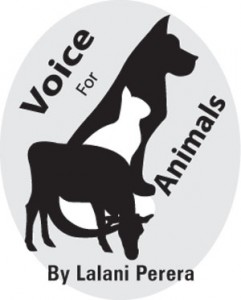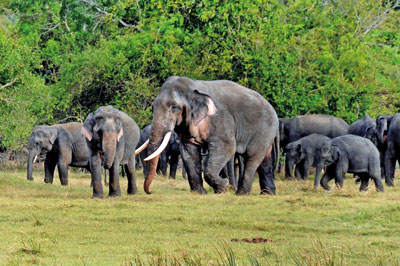Elephantine appeal to save the star of our wildlife
View(s): Elephants are in the news almost daily- as victims or villains.
Elephants are in the news almost daily- as victims or villains.Many admire them for their magnificence, respecting them for their sanctity.For others, they are enemies damaging their property, destroying their crops and killing their loved ones.
The Sri Lankan elephant, listed “endangered” in the IUCN Red List of Threatened Species is depleting- approximately 10,000 at the dawn of the 20th century now dwindled to around 4500.
Sri Lanka’s Human-Elephant Conflict (HEC) annually kills around 70 humans; HEC and other catastrophes also claim about 200 elephant lives.
Though now illegal, in colonial times, elephant hunting was a popular sport. British hunter, Sir Samuel Baker is reputed to have killed countless elephants, once killing 11 before breakfast and another 104 within three days. According to folklore, the gravestone of a British Governor famous for mass elephant slaughter, is annually struck by lightning, for that sin.
In 1937, the Fauna and Flora Protection Ordinance prohibited elephant hunting and killing. The then fine of Rs.2000, now stands enhanced upto Rs.500,000.
Elephant kraals, a timber stockade to trap and tame elephants for domestication was another cruel pursuit. The final kraal in Panamure in 1950,was organized by Sir Francis Molamure, then Speaker, State Council (later Parliament). As “Stranger Times” narrates, the participants of that kraal included top blue bloods of Ceylon, including the Governor General. It was a normal rounding up until the herd was led to the stockade where two females were in estrous.One young bull had run into the stockade, reacting violently when the matriarch who was his “lady love” was noosed. To save kraal participants, the tusker was shot, leading to countrywide commotions and a ban on kraals.Today, a monument honours this Tusker who fought to protect his herd.
HEC occurs when elephants lose their habitat with deforestation for development, illegal felling of trees and encroachment, sometimes with political support. The animals then storm villages in search of food and water.Translocation, elephant drives and electric fences have not mitigated the HEC. Simple options tried are beehive and palmyrah fences – elephants avoiding buzzing and spiky trees. Experts have recommended remedies, but HEC continues. Both human and animal need protection within an environment to co-exist. While commending the National Elephant Conservation Policy, environmentalists lament its non implementation.
There are traditional elephant owners; others acquire elephants for commercial use and prestige, sometimes capturing calves after killing the mother. No welfare standards exist for elephants possessed by individuals, temples and devales, thus exposing them to neglect and cruelty.The Animal Welfare Trust has succeeded in getting the authorities to formulate welfare regulations, which hopefully will soon become law.
With numerous requests for elephants from temples and devales, then President D.B. Wijetunge, in 1994 issued guidelines on donations to religious institutions - donations were to be from Pinnawela, in evaluating the requests, the institution’s need for elephants, its historical tradition in conducting annual peraheras continuously for at least twenty five years, its capacity to maintain the animal,were to be considered. A temple or devale possessing an elephant was ineligible to receive more. Donation of elephants to the temples of the Mahanayake Theros however, remained at Presidential discretion.These guidelines now appear to have become obsolete.

“Sannasas” granting elephants require the animals to be used for religious or cultural activities, but some are hired for other purposes.The Attorney General opines that the Constitution empowers the President to grant only immovable property.
With the CID and the Attorney General now prosecuting persons keeping elephants illegally and taking the animals into custody, a campaign discrediting animal welfare organizations,alleges that they receive foreign funds to destroy Buddhism and culture and hence they are behind the prosecutions. Since there are enough elephants outside, for peraheras, the campaigners are perhaps attempting to mislead the public to gain sympathy.
Our ancient kings exported elephants as tributes or for ceremonial use or warfare. Now, our Heads of State gift baby elephants to foreign nations as symbols of goodwill.Conservationists and animal rights activists state that this affects conservation and separating babies from mothers is cruel. Some argue, why not now, if it happened then? The response – should we perpetuate such practices when animals are being globally recognised as non-human persons with rights and feelings?As Hans Kriek of SAFE, an animal welfare organization in New Zealand comments “elephant gifting is more about politics and international relations than animal welfare.” These “symbols” end up in zoos, deprived of their natural habitat, vulnerable to chronic physical ailments and severe emotional trauma. Mali gifted to the Philippines (1974 )remains isolated in a barren enclosure for forty years;Saheli (Pakistan1991) is alleged to have been poisoned; Kadir (Czech Republic 1971) was put down, as he became a threat when Prague zoo was flooded; Kaavan (Pakistan 1985) is suffering from a mental illness isolated in unfamiliar habitat and the most heartrending is little Jayathu’s fate. Gifted to the United States in 1984 when only twenty months old, Jayathu died within weeks of arrival, of a “mysterious illness” as the New York Times reported, with symptoms of diarrhoea, loss of appetite and weight loss. Calling them “gracious” gifts, some of our diplomats take pride in facilitating gifting. It would be more gracious (and humane) to gift an inanimate object, not a living being with no voice or choice to plead “Don’t take me away from my mother and family.”
In 2005, India discontinued the practice of Heads of State gifting animals.The current Wildlife Minister assuring animal activists that he will not allow elephants to be gifted (while expressing helplessness regarding previous negotiations), publicly declared that he does not like sending elephants abroad. So there is hope.
Elephants die in train accidents; fall into agro wells; get electrocuted; are blasted by hakkapatas; during transport; are struck by lightning, among others.
Train drivers are expected to reduce speed in elephant roaming areas; wildlife authorities talk about installing thermographic cameras to warn train drivers; in Africa, underpasses prevent elephant deaths. Are these only dreams for us?
Wildlife and police officers frequently save elephants who fall into wells; recently, a police officer was killed by the saved victim.Tusker Parakrama died when the floor of the lorry transporting him collapsed. Elephants used for rides, games like polo and New Year festival races are often trained cruelly – the animal tortured until its spirit is crushed and will obey any command, out of fear.
And, now we hear of a government ‘pundit’s outrageous suggestion to sell wild elephants to enhance State coffers and resolve the Human-Elephant Conflict!
The government received global plaudits for destroying tusks found en-route to Dubai, demonstrating Sri Lanka’s zero-tolerance of the illegal ivory trade.
Today, hunting and killing are banned; there are no kraals; but elephants continue to suffer other tragedies.
If elephants could vote, the future of these majestic sentient beings may change, at least a little bit – because there would be a lot more political will to protect them.


